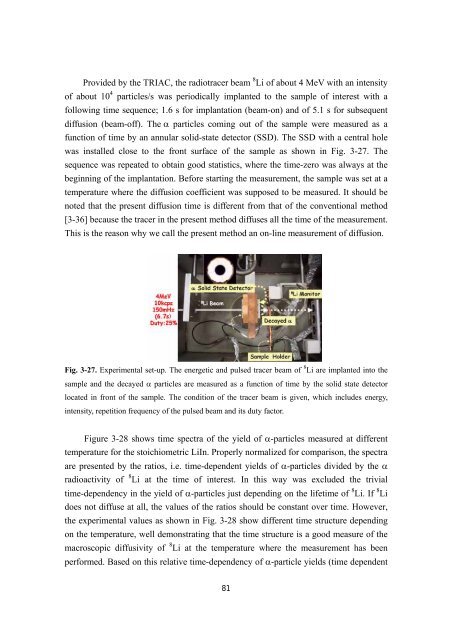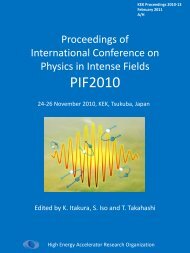TRIAC Progress Report - KEK
TRIAC Progress Report - KEK
TRIAC Progress Report - KEK
Create successful ePaper yourself
Turn your PDF publications into a flip-book with our unique Google optimized e-Paper software.
Provided by the <strong>TRIAC</strong>, the radiotracer beam 8 Li of about 4 MeV with an intensity<br />
of about 10 4 particles/s was periodically implanted to the sample of interest with a<br />
following time sequence; 1.6 s for implantation (beam-on) and of 5.1 s for subsequent<br />
diffusion (beam-off). The α particles coming out of the sample were measured as a<br />
function of time by an annular solid-state detector (SSD). The SSD with a central hole<br />
was installed close to the front surface of the sample as shown in Fig. 3-27. The<br />
sequence was repeated to obtain good statistics, where the time-zero was always at the<br />
beginning of the implantation. Before starting the measurement, the sample was set at a<br />
temperature where the diffusion coefficient was supposed to be measured. It should be<br />
noted that the present diffusion time is different from that of the conventional method<br />
[3-36] because the tracer in the present method diffuses all the time of the measurement.<br />
This is the reason why we call the present method an on-line measurement of diffusion.<br />
Fig. 3-27. Experimental set-up. The energetic and pulsed tracer beam of 8 Li are implanted into the<br />
sample and the decayed α particles are measured as a function of time by the solid state detector<br />
located in front of the sample. The condition of the tracer beam is given, which includes energy,<br />
intensity, repetition frequency of the pulsed beam and its duty factor.<br />
Figure 3-28 shows time spectra of the yield of α-particles measured at different<br />
temperature for the stoichiometric LiIn. Properly normalized for comparison, the spectra<br />
are presented by the ratios, i.e. time-dependent yields of α-particles divided by the α<br />
radioactivity of 8 Li at the time of interest. In this way was excluded the trivial<br />
time-dependency in the yield of α-particles just depending on the lifetime of 8 Li. If 8 Li<br />
does not diffuse at all, the values of the ratios should be constant over time. However,<br />
the experimental values as shown in Fig. 3-28 show different time structure depending<br />
on the temperature, well demonstrating that the time structure is a good measure of the<br />
macroscopic diffusivity of 8 Li at the temperature where the measurement has been<br />
performed. Based on this relative time-dependency of α-particle yields (time dependent<br />
81













